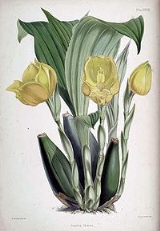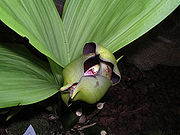
Anguloa
Encyclopedia
Anguloa, commonly known as tulip orchids, is a small orchid genus
closely related to Lycaste
. Its abbreviation in horticulture
is Ang. This genus was described by José Antonio Pavón and Hipólito Ruiz López
in 1798. They named it in honor of Francisco de Angulo, a contemporary Peru
vian who collected orchids as a hobby and by this way had become quite knowledgeable about these plants, assisting the botanists in their work.
This genus is found on the forest floor at high elevations from Venezuela
, Colombia
, Ecuador
to Peru
.
 Tulip orchids are rather large terrestrial
Tulip orchids are rather large terrestrial
and sometimes epiphytic
plants with fleshy pseudobulb
s longer than 20 cm. The long, lanceolate and plicate leaves
of a full-grown Anguloa can be more than 1 m long. Two to four leaves grow from the base of each pseudobulb. The leaves are deciduous
, and are shed at the start of each new growth.
The flower
s of these orchids have a strong scent of cinnamon
. They are of waxy appearance and are (in wild species) either of two colors, depending on the species
– greenish white, or yellow to red. A single flower per inflorescence
arises from the base of each new pseudobulb. The white tulip orchids have six inflorescences per pseudobulb, the other can produce up to twelve inflorescences. The sepal
s have a bulbous shape, resembling a tulip
; hence the common name. The lip
is three-lobed. The column
has four pollinia
.
of tulip orchids, with varieties known of some of these. In addition, there are 4 natural hybrids, which might eventually evolve
into distinct species with self-sustaining populations. Other hybrid tulip orchids are bred by horticulturalists, but do not occur in the wild.
Genus
In biology, a genus is a low-level taxonomic rank used in the biological classification of living and fossil organisms, which is an example of definition by genus and differentia...
closely related to Lycaste
Lycaste
Lycaste, abbreviated as Lyc in horticultural trade, is a genus of orchids that contains about 30 species with egg-shaped pseudobulbs and thin, plicate leaves.- Description :...
. Its abbreviation in horticulture
Horticulture
Horticulture is the industry and science of plant cultivation including the process of preparing soil for the planting of seeds, tubers, or cuttings. Horticulturists work and conduct research in the disciplines of plant propagation and cultivation, crop production, plant breeding and genetic...
is Ang. This genus was described by José Antonio Pavón and Hipólito Ruiz López
Hipólito Ruiz López
Hipólito Ruiz López , or Hipólito Ruiz, was a Spanish botanist known for researching the floras of Peru and Chile during an expedition under Carlos III from 1777 to 1788...
in 1798. They named it in honor of Francisco de Angulo, a contemporary Peru
Peru
Peru , officially the Republic of Peru , is a country in western South America. It is bordered on the north by Ecuador and Colombia, on the east by Brazil, on the southeast by Bolivia, on the south by Chile, and on the west by the Pacific Ocean....
vian who collected orchids as a hobby and by this way had become quite knowledgeable about these plants, assisting the botanists in their work.
This genus is found on the forest floor at high elevations from Venezuela
Venezuela
Venezuela , officially called the Bolivarian Republic of Venezuela , is a tropical country on the northern coast of South America. It borders Colombia to the west, Guyana to the east, and Brazil to the south...
, Colombia
Colombia
Colombia, officially the Republic of Colombia , is a unitary constitutional republic comprising thirty-two departments. The country is located in northwestern South America, bordered to the east by Venezuela and Brazil; to the south by Ecuador and Peru; to the north by the Caribbean Sea; to the...
, Ecuador
Ecuador
Ecuador , officially the Republic of Ecuador is a representative democratic republic in South America, bordered by Colombia on the north, Peru on the east and south, and by the Pacific Ocean to the west. It is one of only two countries in South America, along with Chile, that do not have a border...
to Peru
Peru
Peru , officially the Republic of Peru , is a country in western South America. It is bordered on the north by Ecuador and Colombia, on the east by Brazil, on the southeast by Bolivia, on the south by Chile, and on the west by the Pacific Ocean....
.
Description

Terrestrial plant
A terrestrial plant is one that grows on land. Other types of plants are aquatic , epiphytic , lithophytes and aerial ....
and sometimes epiphytic
Epiphyte
An epiphyte is a plant that grows upon another plant non-parasitically or sometimes upon some other object , derives its moisture and nutrients from the air and rain and sometimes from debris accumulating around it, and is found in the temperate zone and in the...
plants with fleshy pseudobulb
Pseudobulb
The pseudobulb is a storage organ derived from the part of a stem between two leaf nodes.It applies to the orchid family , specifically certain groups of epiphytic orchids, and may be single or composed of several internodes with evergreen or deciduous leaves along its length.In some species, it is...
s longer than 20 cm. The long, lanceolate and plicate leaves
Leaf
A leaf is an organ of a vascular plant, as defined in botanical terms, and in particular in plant morphology. Foliage is a mass noun that refers to leaves as a feature of plants....
of a full-grown Anguloa can be more than 1 m long. Two to four leaves grow from the base of each pseudobulb. The leaves are deciduous
Deciduous
Deciduous means "falling off at maturity" or "tending to fall off", and is typically used in reference to trees or shrubs that lose their leaves seasonally, and to the shedding of other plant structures such as petals after flowering or fruit when ripe...
, and are shed at the start of each new growth.
The flower
Flower
A flower, sometimes known as a bloom or blossom, is the reproductive structure found in flowering plants . The biological function of a flower is to effect reproduction, usually by providing a mechanism for the union of sperm with eggs...
s of these orchids have a strong scent of cinnamon
Cinnamon
Cinnamon is a spice obtained from the inner bark of several trees from the genus Cinnamomum that is used in both sweet and savoury foods...
. They are of waxy appearance and are (in wild species) either of two colors, depending on the species
Species
In biology, a species is one of the basic units of biological classification and a taxonomic rank. A species is often defined as a group of organisms capable of interbreeding and producing fertile offspring. While in many cases this definition is adequate, more precise or differing measures are...
– greenish white, or yellow to red. A single flower per inflorescence
Inflorescence
An inflorescence is a group or cluster of flowers arranged on a stem that is composed of a main branch or a complicated arrangement of branches. Strictly, it is the part of the shoot of seed plants where flowers are formed and which is accordingly modified...
arises from the base of each new pseudobulb. The white tulip orchids have six inflorescences per pseudobulb, the other can produce up to twelve inflorescences. The sepal
Sepal
A sepal is a part of the flower of angiosperms . Collectively the sepals form the calyx, which is the outermost whorl of parts that form a flower. Usually green, sepals have the typical function of protecting the petals when the flower is in bud...
s have a bulbous shape, resembling a tulip
Tulip
The tulip is a perennial, bulbous plant with showy flowers in the genus Tulipa, which comprises 109 species and belongs to the family Liliaceae. The genus's native range extends from as far west as Southern Europe, North Africa, Anatolia, and Iran to the Northwest of China. The tulip's centre of...
; hence the common name. The lip
Labellum
Labellum is the Latin diminutive of labium, meaning lip. These are anatomical terms used descriptively in biology, for example in Entomology and botany.-Botany:...
is three-lobed. The column
Column (botany)
The column, or technically the gynostemium, is a reproductive structure that can be found in several plant families: Aristolochiaceae, Orchidaceae, and Stylidiaceae....
has four pollinia
Pollinium
Pollinium, or plural pollinia, is a coherent mass of pollen grains in a plant.They are the product of only one anther, but are transferred, during pollination, as a single unit. This is regularly seen in plants such as orchids and many species of milkweeds .Most orchids have waxy pollinia...
.
Species
There are nine speciesSpecies
In biology, a species is one of the basic units of biological classification and a taxonomic rank. A species is often defined as a group of organisms capable of interbreeding and producing fertile offspring. While in many cases this definition is adequate, more precise or differing measures are...
of tulip orchids, with varieties known of some of these. In addition, there are 4 natural hybrids, which might eventually evolve
Evolution
Evolution is any change across successive generations in the heritable characteristics of biological populations. Evolutionary processes give rise to diversity at every level of biological organisation, including species, individual organisms and molecules such as DNA and proteins.Life on Earth...
into distinct species with self-sustaining populations. Other hybrid tulip orchids are bred by horticulturalists, but do not occur in the wild.
- Anguloa × acostae (Colombia)
- Anguloa brevilabris
- Anguloa cliftonii
- Anguloa cliftonii var. alba
- Anguloa cliftonii var. concolor
- Anguloa clowesiiAnguloa clowesiiAnguloa clowesii is a species of orchid....
- Anguloa clowesii var. flava
- Anguloa dubia
- Anguloa eburnea
- Anguloa hohenlohii
- Anguloa hohenlohii var. hohenlohii
- Anguloa × rolfei (unplaced name) (Colombia)
- Anguloa × ruckeri (A. clowesii × A. hohenlohii) (Venezuela)
- Anguloa × speciosa (Venezuela and probably Colombia)
- Anguloa tognettiae
- Anguloa unifloraAnguloa unifloraAnguloa uniflora is a species of orchid and is the type species of its genus....
- Anguloa virginalis
- Anguloa virginalis var. turneri

